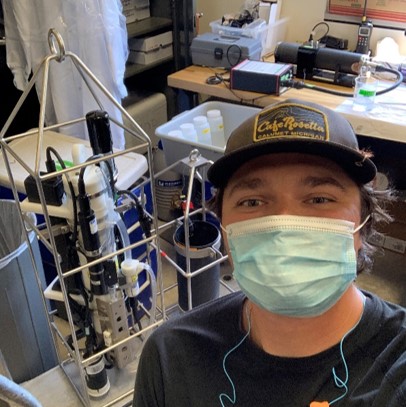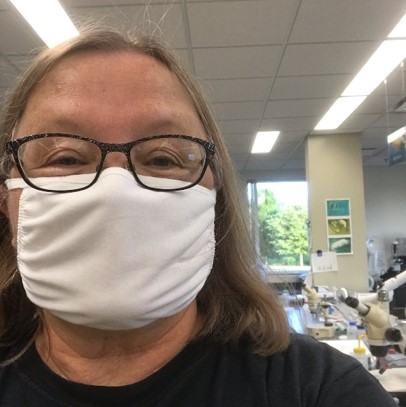Summer 2020 eNewsletter
Spotlight: Great Lakes Photo Field Guide to 2020 Summer Research
CIGLR has had a busy summer research season, both in the laboratory and in the field. After a delayed start to protect our health and safety, by mid summer CIGLR and NOAA GLERL resumed limited field and laboratory operations to ensure that critical Great Lakes research continues to serve the stakeholders that rely on our products and services. We hope you enjoy this Great Lakes Photo Field Guide to our 2020 COVID-safe summer research!

Hypoxic water can be corrosive and sometimes have elevated amounts of manganese, impacting drinking water. Aquatic Ecology Research Technician Christine Kitchens analyzes 2019 Lake Erie Central Basin dissolved manganese samples to better understand this phenomenon. Photo Credit: Christine Kitchens.

Benthic Ecology Research Technician Glenn Carter uses a HyperGun to help CIGLR and NOAA GLERL maintain critical water quality observations that are essential for documenting the potential growth and spread of harmful algal blooms on Saginaw Bay, Lake Huron. The HyperGun is a handheld Hyperspectral Color Radiometer (HyperOCR) and is used to measure the different wavelengths of light given off by the atmosphere and the lake. Photo Credit: Dennis Donahue.

CIGLR Engineers Russ Miller and Heidi Purcell deploy the NOAA GLERL western Lake Erie buoy in July 2020. Buoys are a great source of Great Lakes data. They provide measurements like wind speed, water and air temperature, and wave height. Photo Credit: Kent Baker.

Benthic Ecology Research Technician Andrew Camilleri uses a dissection microscope to count and identify benthic (lake bottom) invertebrates including zebra and quagga mussels and Hexagenia (mayfly) larvae. Hexagenia are the preferred prey of many Great Lakes fish species. Their populations declined dramatically in the 1950s due to eutrophication, but recent evidence indicates that populations are now returning in some areas. This will likely have a positive impact on energy-flow pathways through the food web in areas where it becomes re-established. Photo Credit: Andrew Camilleri.

Aquatic Ecology Research Analyst Holly Kelchner filters water from Saginaw Bay, Lake Huron for dissolved inorganic nutrients (DINs). DINs are composed of nitrate plus nitrite and ammonium. These forms of nitrogen are readily available to phytoplankton and can control the formation of algal blooms. Photo Credit: Kent Baker.

Environmental Observing Systems Engineer Hayden Henderson prepares his benchtop for western Lake Erie water samples. Collected from the lake just hours prior, these samples are run through a Fluoroprobe. This instrument aids in understanding changes in algal species in the lake across space and time. Photo Credit: Hayden Henderson.

Invasive zebra and quagga mussels arrived in the Great Lakes in the ballast water of shipping vessels. Benthic Ecology Research Technician Michele Wensman prepares her laboratory workstation to separate mussels by size and species, helping us learn more about mussel growth and their impacts on the Great Lakes. Photo Credit: Michele Wensman.
